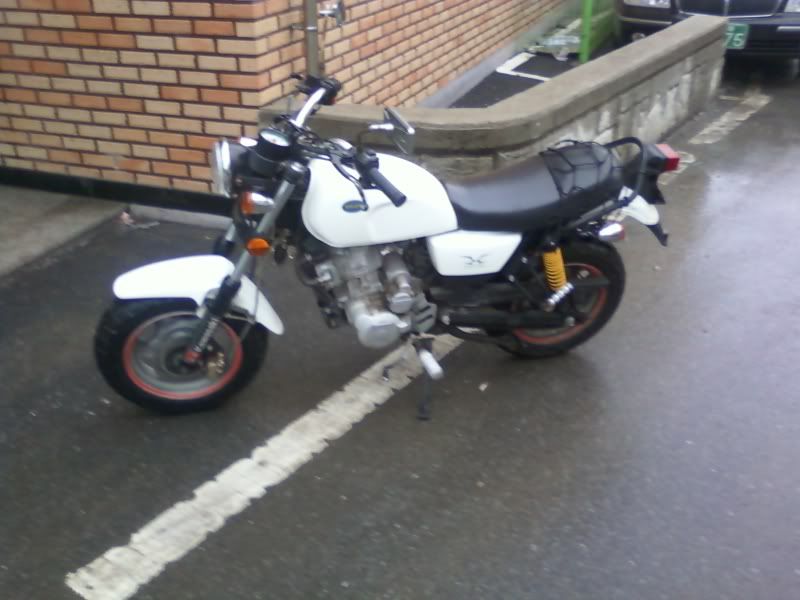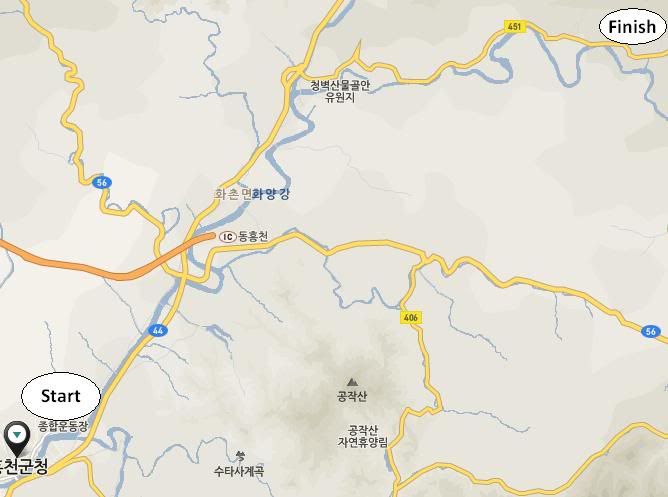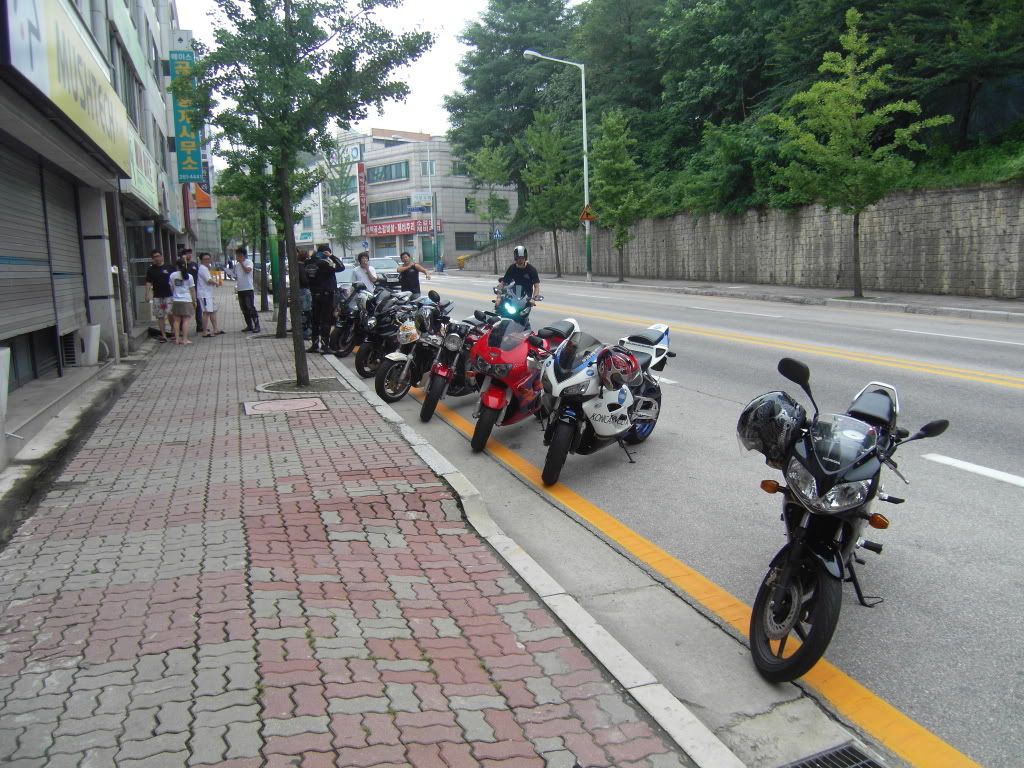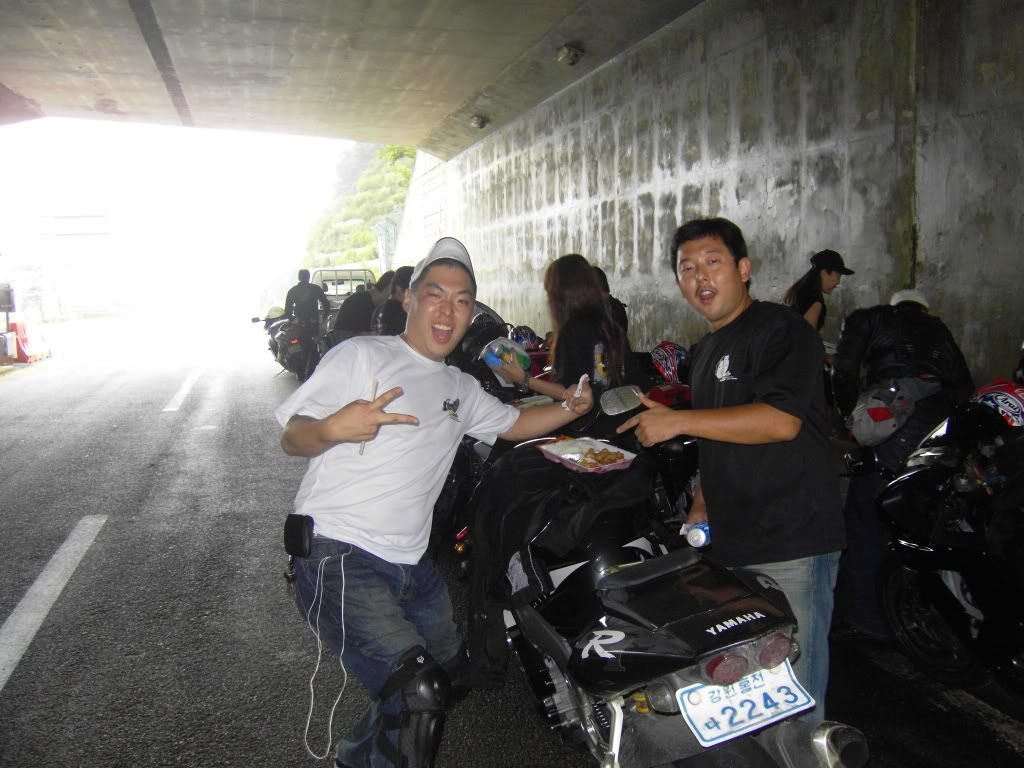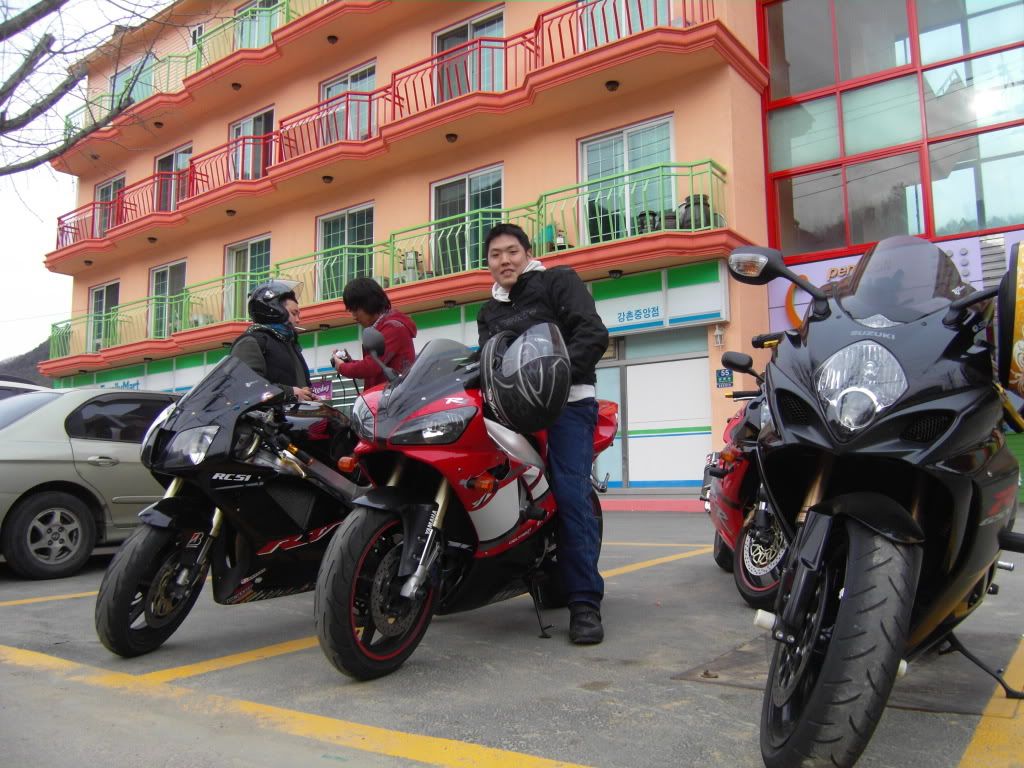
Well, as far as I can tell, there are four primary types of riding and different bikes will fit the bill for whatever riding you're hoping to do.
1) City Riding
2) Tour Riding
3) Sport Riding
4) "Adventure" Riding
City riding is tough in Korea because traffic patterns are difficult to predict. Unless you are extremely aware of where everything is, trying to find someplace while on a bike is difficult because you need to keep your attention on the road as well as trying to decipher the thousands of Korean signs. As I had previously mentioned, traffic patterns are highly erratic and dangerous for motorcycle riding in Korea. Personally, I don't particularly enjoy city riding and try to avoid riding on local roads for the most part. That being said, there is the easiest option; scooters.
Many people opt for scooters because
you don't have to shift gears, they are easy on maintenance and you get incredible mileage. Just to give you an idea, I had a buddy who had scooter problems and when he got his carburetters cleaned and his
spark plug repaired, it cost him 10,000 Won. Other advantages of opting for a scooter is the fact that you don't need to have a license to ride one, you have plenty of cheap options as there are plenty of Korean and Chinese brands to buy and most of them have good sized trunks for if you want to go grocery shopping with. Scooters look dinky and it's more or less embarrassing to ride a scooter in America, but everyone in Korea rides them. A good scooter can be bought for as low as 300,000 Won, but expect any shop to try and get an extra 100,000-200,000 Won out of you. Conditions, made year, etc. all come into the calculation, but scooters will generally run forever and fixing them costs little. If it runs when you test ride it, it's in good enough condition.
Okay, so since we've covered scooters, let's move on. If you're just looking for an easy way to get around town a scooter is fine, but let's face it, most people who are riding scooters do so because they can't afford the hassle of a car, but are too lazy for a pedal bike. Long distance rides in Korea are difficult on a scooter as they generally can't do more than 80km/h and that's talking about a flat road with the wind on your back. The entire peninsula of Korea is one giant mountain range and trying to make it up hill on a scooter is just dangerous as cars will pass you at speed and the brakes aren't great so going downhill isn't any safer so you can pretty much forget about leaving town unless you're really dedicated to the task. There are "big scooters" available, but they go up in price and down in reliability.
The next level is the 125cc class of bikes that are rampant in Korea. The bikes you'll see in this range are the Hyosung Exiv ("sporty"), Hyosung Mirage (cruiser), Daelim Roadwin ("sporty"), and Daelim Daystar (cruiser). These are the most popular and easiest to find. A good condition Exiv or Daelim will run you around 800,000 - 1,500,000 Won. A good condition Mirage will run you between 700,000 - 1,500,000 Won. A good condition Daystar can be found for as low as 500,000 Won. There are also plenty of offerings in this class from various Chinese brands like HSRC and the pricier Japanese brands like Honda. These bikes will generally get to around 100km/h. The speedos will indicate up to 140km/h if you're going downhill and you have the wind at your back, but it's just lying to you. These bikes mostly require you to know how to shift gears, but are fun for getting around town and can occasionally get you out of town. They can keep up with car traffic for the most part and will maintain 80-90 km/h on a 10% grade hill climb. When I had my 125cc Exiv, I took frequent trips between HongCheon and ChunCheon. So now the choices boil down to; Korean or Import and Sporty or Cruiser. Japanese bikes are better made. Period. The problem is that they are expensive to buy and expensive to keep in repair.
Korean bikes have been getting better and will be cheaper to keep in repair and the biggest plus is that every bike shop will know how to work on it so you won't have to shop around to find a shop that knows what they're seeing when they look at an import. Chinese bikes are all rip offs so just find the Korean/Japanese equivalent and you'll have a good idea.
General Maintenance Costs for Scooters and 125cc bikes:
Fuel: 5,000 Won will last you aroound a week if you're using it for 30 minute daily commutes + random shopping and moving.
Oil Change: 5,000-10,000 Won for the oil and the filter. These bikes need oil changes every 500-750 km. You can opt for better oil, but it's not really worth it unless you care more about longevity than cost.
Carburetter Cleaning: 5,000-10,000 Won
Spark Plug Replacement: 2,000-6,000 Won

Now, this is a bike I had and the bike I believe to be perfect for Korea; Hyosung 250 class of bikes. There are three Korean models; The Daelim VFJ-i Roadwin 250(sporty), Mirage(cruiser) and the Comet(sporty). There are two versions of the Comet; Faired and non-faired. Faired just means it has those cool looking plastic covers. You can go and Google the specs on this bike or read what I wrote beforehand about the bike. Why is it so good for Korea? The Hyo 250 class of bikes get good gas mileage. I couldn't tell you exactly what the mileage is as I never calculated gas mileage, but they have the range to get you from the east coast of Korea to the west coast on one tank of gas. These bikes will get you to around 160 km/h (roughly 100mph). They deliver power smoothly so there's never a surprise when you crank the throttle. The cost of maintenance runs more than the above two options, but is still relatively cheap compared to bigger imports. You don't have to shop quite as hard to find a shop that can work on these bikes because they are very similar to their 125cc counterparts and most shops will be able to do whatever you need for their repairs. Although the shops will recommend standard oil, I'd recommend at least a semi-synthetic (rough 40,000 Won for two bottles + filter) as these bikes are a bit more sophisticated than smaller bikes. The best part about the 250 is that it also works to get you around Korea. It can maintain speed on any hill, corner, etc. The only thing I would suggest is you change the tires if you plan on riding in the rain because the stock tires are HORRIBLE HORRIBLE HORRIBLE when it's wet. When I was riding my Hyo Comet GT250R, I made frequent trips to Sokcho without any real issue.
Now, all that being said about the 250, I will tell you that I did manage to destroy my 250's transmission and motor. The 250 motor works if you just want to cruise or if you want to commute or do some exploring. The 250 motor will not work if you plan on riding at speed consistently and do more "extreme" riding. I rode my 250 at full open throttle everywhere and this motor is not meant for that. As a learner, the 250 is perfect as well, but if you have riding experience and you plan on riding fast just move on to a "bigger" bike. Don't let this detract you from purchasing one, she simply died on me because I did some naughty things with her.
Tour Riding, Sport Riding, Adventure Riding. I can't really comment on the last. I have never hit a dirt trail nor have I ever ridden a dirt bike. However, there are plenty of places to do it if that's your thing. One thing Korea has in abundance are offroad areas. You can find trail bikes relatively cheap as Koreans don't find them very practical and resale value suffers as a result. Now, the two things I am a bit more familiar with; Tour Riding and Sport Riding.
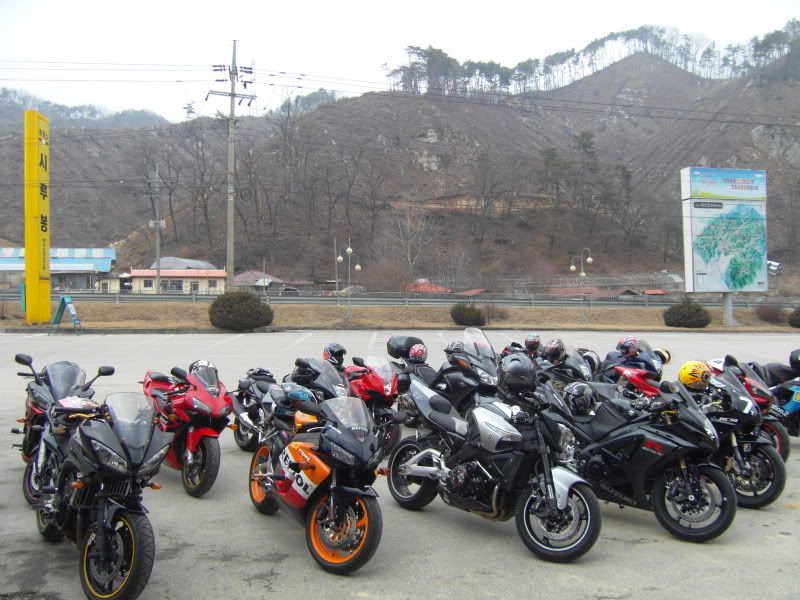
Tour Riding in Korea involves taking 1+ hour trips at "extra-legal" speeds. I know, I know (well, if you are American, I can't speak for other nations) that we are bred to keep an eye on our rear view mirror for state troopers who will take us to the bank if we are a bit "liberal" with our speed. This rule doesn't apply quite as much when riding in Korea. I mentioned this in my last entry. Tour Riding can involve any bike, I've even seen people tour on scooters (I know I mentioned that they aren't much for anything besides scooting around town) clinging desperately to the right lane or shoulder. Although motorcycles are not allowed on the highways, there are plenty of "inter-province roads" or "county roads" that you can ride on which are more or less highways. You have to be careful as these turn from two-lane highway-esque roads into dusty backroads without warning. There are also instances where they will just turn into "cars only" roads where motorcycles aren't supposed to ride without any warning, but don't worry about this because if you get pulled over you can just explain that you're a dumb foreigner and feign ignorance. These "cars only" roads are actually the non-toll gated high ways I mentioned in my "Riding Rules" entry. My recommendation is to find motorcycle "cafes" (다음카페)on daum.net, wave down another rider, or find a shop where Korean riders hang out. Getting in with a riding group or a touring group is tons of fun and they'll show you all the great roads and it's a great way to explore Korea with people who know it best. Most motorcycle enthusiasts in Korea are some of the kindest and most outgoing people that I have met to date. The motorcycle groups that give you the cold shoulder are usually filled with assholes you won't want to involve yourself with anyways. That leads me to Sport Riding.

Sport Riding in Korea has both major advantages and disadvantages. Proper sport riding should be done on a track, but let's face it... if you tally up the cost of track time, cost of tires, finding a good way to transport your bike, and everything else that's involved, it's just not practical in Korea. There are only a couple tracks that I know of in Korea and I have heard that one of them shut down. The one that I know is still in business is in TaeBaek. Alright, the track itself is okay, but the layout and administration leaves a lot to be desired. The run-offs are kind of small so I can see it fully possible for people to hit a wall if they have an "off" at a decent speed. It has your basic layout, long straight at the start/finish, long sweeping back stretch, a couple techincal corners, off-camber corners, etc. However, there are no braking zone indicators at corner entire, which would make it difficult for learners to get on with it. My biggest problem with the track is the way that it is run. First, you need to get a "license", which is pretty much a registration fee and a run through the course. The way they run the track days are that they have 20 minute sessions and no real "track" instruction. If you know anything about trackdays in the US, they generally have some sort of instruction, on-site staff to help you adjust your suspension and other settings, and other facilities at your disposal. As far as I can tell, a "track day" at TaeBaek Motor Park is an entry fee like you would pay at an amusement park. It's a wonder why motorsports are at such an infantile stage in this country. Criticisms aside, it's your only option for actual track time so take it or leave it. I decided not to bother unless some incredible opportunity arises, I'll save my kneed sliders for when I get back to America.
Now, the major advantage if you like sport riding are the number of nice mountain roads and twisties available to you. Here's a sample. The road condition on this particular road isn't the greatest, but there are plenty of others. If I ever get a chance to film them, I'll post them up.

There are many corners you can see all the way through the turn so that you don't have to
worry about slow-moving vehicles and the way uphill is double laned so passing slower vehicles is generally not a problem. Another major bonus is that the highway system has become really developed so cars generally stay away from these roads and stick to the highways. If you are in Gangwon-do and are interested in finding mountain twisties by you, feel free to contact me. I know twisties in every corner of this province. I don't know them all, but I've at least passed through most of the clean and fun to ride ones.

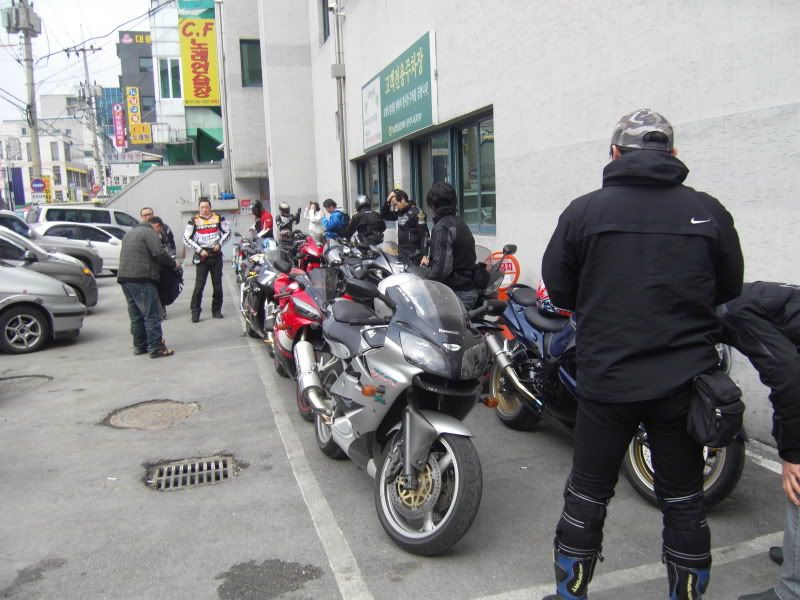





 ts. Don't ride in shorts. Don't ride in shorts. Don't ride in shorts. Actually, if you like skin grafts and want to rub off some skin into the asphalt, go ahead. Jeans actually offer little to no protection, but I'd recommend heavy jeans as the utmost minimum as they will give you at least a few seconds before you're using your own skin to protect your bones from being grinded down. The leather pants on the left are the lower piece that zip up to the jacket to make a full suit. The jeans on the right are "kevlar enforced" riding jeans from
ts. Don't ride in shorts. Don't ride in shorts. Don't ride in shorts. Actually, if you like skin grafts and want to rub off some skin into the asphalt, go ahead. Jeans actually offer little to no protection, but I'd recommend heavy jeans as the utmost minimum as they will give you at least a few seconds before you're using your own skin to protect your bones from being grinded down. The leather pants on the left are the lower piece that zip up to the jacket to make a full suit. The jeans on the right are "kevlar enforced" riding jeans from  Leather Gloves - Basic principle behind leather gloves is like that of all your other gear, that the leather will be rubbed off when you skid on the ground before it gets to the soft and delicate skin on your hands. I've gone down without gloves
Leather Gloves - Basic principle behind leather gloves is like that of all your other gear, that the leather will be rubbed off when you skid on the ground before it gets to the soft and delicate skin on your hands. I've gone down without gloves



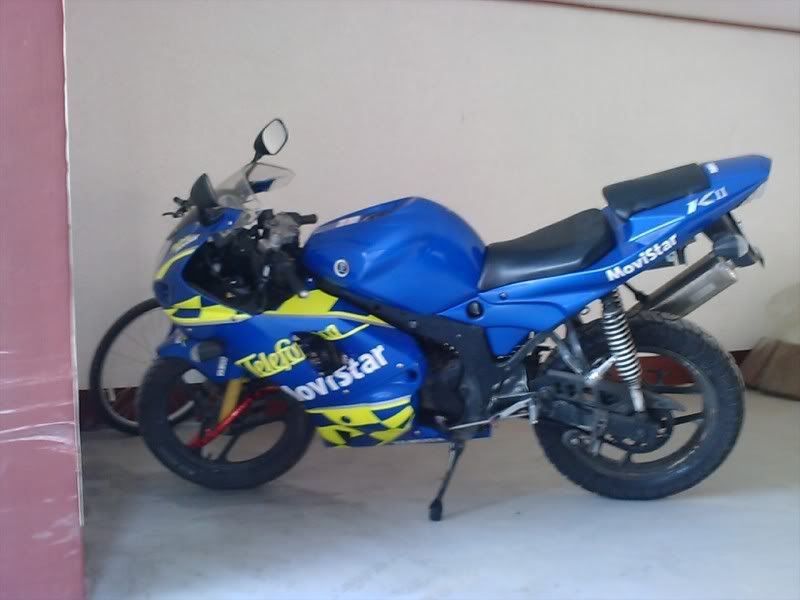
 The Hyosung Comet GT250R and the Yamaha R1 were bought through online websites.
The Hyosung Comet GT250R and the Yamaha R1 were bought through online websites.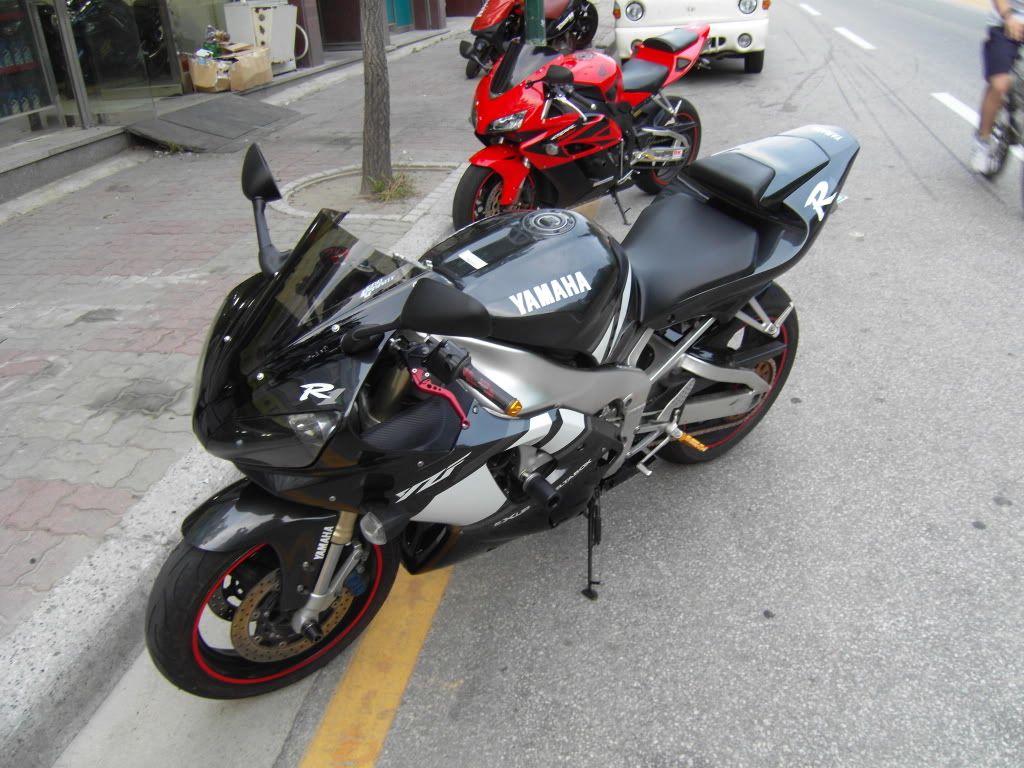 because their parents found out they had secretly bought one. The Korean word for negotiation is "절충" so if it says "절충가능" the price is negotiable and "절충불가능" mean the price is not negotiable. You have to be extra wary when purchasing a bike online, but there are plenty of good bikes available and people post up ads daily. I would recommend you use Passo over Bikemart as Passo is more popular and people tend to post up cheaper prices, but it doesn't hurt to check both.
because their parents found out they had secretly bought one. The Korean word for negotiation is "절충" so if it says "절충가능" the price is negotiable and "절충불가능" mean the price is not negotiable. You have to be extra wary when purchasing a bike online, but there are plenty of good bikes available and people post up ads daily. I would recommend you use Passo over Bikemart as Passo is more popular and people tend to post up cheaper prices, but it doesn't hurt to check both.